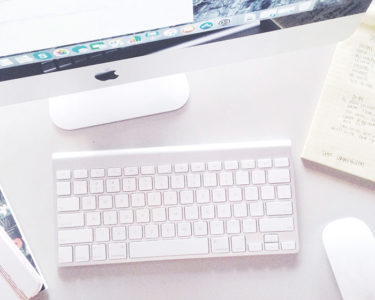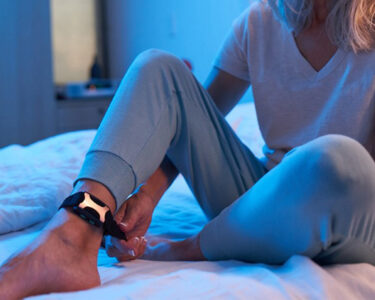I’m rounding our my 2016 Goals series with a problem that isn’t talked about too much, but affects anyone I know who spends a lot of time at a computer: Eye strain. I know that when I’ve been writing or reading on screens for days on end, my eyes really start to feel it. My vision gets blurry, and sometimes I’ll even get a headache. Doctors have an official diagnosis for this—Computer Vision Syndrome—and say it’s caused by two things: one, our eyes becoming too dry, and two, fatigue in the tiny muscles that our eyes use to focus.
Staring at a computer screen is harder on our eyes than staring at a paperback for a number of reasons. With a paper book, we’re often looking down, so our eyelids cover more of our eyeballs and keep them moist. With a computer monitor straight ahead of us, we expose more of our eyeballs to air, drying those poor suckers out. We also blink a whopping 66 percent less while working on a computer, according to Christine Sindt, of the University of Iowa. (Weirdly, researchers have found we blink less completely, too— #geekfacts.) Sindt also notes that monitor’s refresh rate of 60 Hz causes a very slight flicker that also causes fatigue, as our eyes are constantly fighting to refocus.
Moreover, we then go and hold our smartphones and tablets closer to our faces than we would a printed matter—as close as seven or eight inches away. According to research published in The Journal of the American Academy of Optometry, that’s a disaster for focusing, which causes further strain.
Since I make my living dealing with screens of all shapes and sizes (and on top of that, I’m a very visual person who really needs to be able to, you know, see) I went in search of ways to prevent eye strain and keep my peepers healthy and happy. Here’s what I found.
Change the Climate Around Your Desk
Position your monitor straight ahead, 20 to 28 inches away from you. Next, close or partially close window blinds to reduce glare, and use desk lamps or a floor lamp instead of harsh, yellow overhead lights. Ooh, nice ambiance!
Wipe down that monitor regularly with a microfiber cloth or sponge to keep it crystal clear. Dust and schmutz build up on your screen and decrease sharpness, forcing eyes to work that much harder to decipher visual information through the haze.

If your eyes still feel super dry when you’re using a computer, try using a mini humidifier at your desk. This teeny version from Cyanics is USB powered and… well, it’s super-cute.
20-20-20 Breaks
With many of us putting in 9 or 10 hours a day in front of a screen, it’s crucial to stop and take frequent breaks to let our eyes rest. For every 20 minutes of work, take a 20-second break and focus on something 20 feet away, suggests the American Academy of Opthalmology. The graceful willow tree in the yard perhaps, or that hot guy from accounting—whatever works.
I know, I know, you get caught up in what you’re doing. Use a program like SmartBreak, which tracks your keyboard activity to figure out how much you’ve been working and then reminds you to look away, blink or adjust your posture, depending on if you need a “break break” or a micro break.
The website Protect Your Vision is a more basic free timer; click “start PYV” on one of three modes and it will alert you when it’s time for a break to avert your eyes, close them, or do some eye gymnastics. Choose from a 20-second break after 20 minutes, a five-minute break to get up and move around after every hour spent at the computer, or a custom break of your choosing.
If you want to be Zen about your breaks, Awareness will play the sound of a Tibetan singing bowl after one hour of computer use. It won’t lock your computer or anything, but it’s a nice reminder to close your eyes, stand up for a stretch, and grab a drink of water.
Specs Appeal
Even if your prescription for contacts or glasses is up to date, you still may need a different prescription for computer use, according to the American Optometric Association. You may need a weaker prescription for computer use, since the screen is farther away, or, you might need bifocals or varifocals (a blended bifocal). Additionally, special lens powers, tints or coatings may help. The association also says that vision therapy (exercises) can be prescribed; these can be done at home to help your eyes and brain work together more effectively.
Computer glasses designed to prevent eye strain are worn by serious gamers and programmers, and there’s no reason the rest of us can’t get in on the action: Gunnar Optiks’ computer eyewear is available in both prescription and non, and helps out in a variety of ways. The glasses are wrapped closely around the face, which designed to limit air currents and boosts humidity around the eyes. The lenses also prefocus light, allowing the eyes’ ciliary muscles to relax, rather than constantly flexing to focus. The coating on the lenses protects from artificial blue light from the screen, says Gunnar, and glare from light around you in your office. Lastly, the lenses have a slight magnification. One of my editors tested a pair out and fell in love, so they may be worth a try if you have really dry eyes.
Another option is a pair of glasses created specifically for use with digital devices. Eyezen lenses come in three designs, based on which type of device the wearer uses most often: smartphone/tablet, computer, or TV, and can be further personalized by your preferred distance from the screen. The lenses also have a light-filtering technology that the company claims will protect the eyes from long-term effects of blue-violet light emitted from digital screens. I’ve been wearing a pair of these at CES all week (pictured on my head above), while constantly writing and reading on devices, and while I’m not sure they’ve made a major difference, I know I’ve been headache-free all week.
Either of these products have the added benefit of making you look bookishly bespectacled, as well as giving your eyes a break.
Blue Light
You already know that using an iPad, desktop or smartphone before bed can disrupt your sleep—this is a particular bugaboo for teenagers, who tend to stay up late texting each other endless streams of “Sup, U there?”
The blue light emitted from our beloved screens have negative health effects, and can stimulate our brains, delaying sleep by suppressing the secretion of melatonin, according to Harvard sleep researchers. F.Lux software fixes this, changing the color temperature of your display, according to the type of light you are using and the time of day. When your screen matches the color of the ambient light around you, you won’t need to adjust the brightness of your monitor as often, which is better for your eyes and for your ability to and, you’ll hopefully sleep better.
For more on F.Lux, check out this video I did for uLive!
Go Big or Go Home
Why squint to see a teensy font when you can relax with a larger version? To enlarge the whole screen or part of the screen, there are several simple shortcuts.
On a Mac, go to System Preferences > Accessibility. You can choose keyboard shortcuts to zoom, or choose scroll gesture to use the mouse or trackpad to zoom in. There are also a couple of zoom styles to choose from, including full screen, or portion of the screen—you reach those by clicking on the More Options button.
On Windows, the Magnifier option can be accessed by clicking Start > Magnifier. There are three modes: full screen, lens mode (which magnifies the area around the mouse) and docked mode (magnifies a portion of the screen and leaves the rest of your desktop alone).
And if you’re online, increase the size of your browser font to take some of the strain off your peepers.
How many fingers am I holding up? Excellent! You are off to a great start for 2016. For even more ways to stay healthy, and for ways tech can help, click here.






